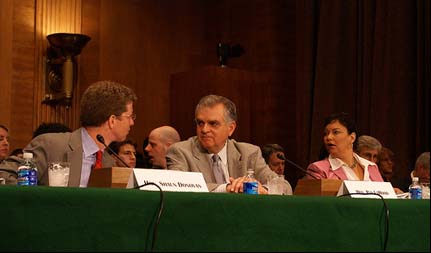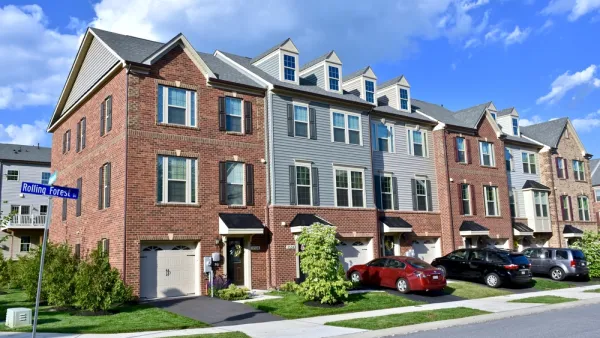Robert Puentes argues that a new federal interagency partnership, debuted before the Senate this week, could provide the federal leadership necessary for a unified vision of transportation, housing, and environmental policy designed to tackle our interrelated economic, energy, and climate challenges.
 By the annals of Congress, it's seemingly unremarkable, but an extraordinary hearing took place this week at the Senate Banking Committee. The secretaries of Transportation, Housing and Urban Development, and the administrator of the Environmental Protection Agency, appeared together and specifically spoke about cooperating to tackle the big economic, energy, and environmental challenges facing the country.
By the annals of Congress, it's seemingly unremarkable, but an extraordinary hearing took place this week at the Senate Banking Committee. The secretaries of Transportation, Housing and Urban Development, and the administrator of the Environmental Protection Agency, appeared together and specifically spoke about cooperating to tackle the big economic, energy, and environmental challenges facing the country.
To do so, they promised a fundamentally new approach to transportation policy and recognized that the system we have in place today is no longer up to the task.
It may not seem like much, but it is a sea change in how Washington does business. It's also a necessary change as we'll need every ounce of creativity and innovation to surmount the historic economic, energy, and environmental hurdles we face today.
This nation's growth will magnify the task. Between now and 2030, it is anticipated that we will develop another 213 billion square feet of homes, retail facilities, office buildings and other structures. That's two-thirds the amount of built space existing in the United States today.

So, how and where we build in the future carries far-reaching implications for the health of our environment, our energy security, and our economic recovery-and will continue to impact our metropolitan areas' success and America's ability to compete globally.
Unfortunately, at the precise time when the nation desperately needs to prioritize its limited resources (given the economic downturn) federal policy on these fronts is only slowly coming into focus.
Foremost are several structural problems.
Overall, the federal government is absent where it should be present on such critical matters as stimulating metropolitan problem solving. Next, federal policies addressing housing and transportation are compartmentalized and ultimately fail to make the necessary connections with land use. And, in addition to being separated, some related federal policies actually seem to work at cross-purposes.
So, in addition to the very fact that these three cabinet members discussed their approaches for a coordinated and integrated partnership, the hearing was notable for three specific proposals:
First is the articulation of a set of "livability principles" that will provide the basis for this new interagency partnership. The principles that the policies will support are certainly noteworthy: transportation choices, affordable housing, economic competitiveness, and stronger communities and neighborhoods.
And together they represent what has been missing for so long: federal leadership and a new, unified vision for integrated transportation, housing, and environmental policy.
Second is the announcement by committee Chairman Sen. Christopher Dodd (D-Conn.) to empower places through a new set of federally-funded competitive grants. These proposed grants would seek to assist states and metropolitan areas in one of their hardest tasks: developing truly integrated transportation, land use, and economic development plans to serve projected growth over the next several decades. They would be awarded to entice states and metropolitan areas to devise their own innovations for coping with congestion and greenhouse gas emissions across transportation, housing, land use, economic development, and energy policies.

Third was a pledge by the panel and the chairman to ensure that housing consumers and suppliers are made aware of the full direct costs of housing. The aim is to maximize government performance and redefine what we mean by "affordable" housing to take into account not only the cost of the housing, but also the cost of transportation and energy associated with that housing.
The hearing highlighted the Housing and Transportation Affordability Index, a groundbreaking innovation because it prices the trade-offs that households make between housing and transportation costs and the savings that derive from living in communities that are near shopping, schools, and work, and that boast a transit-rich environment. An interactive website developed by the Center for Neighborhood Technology shows how this tool can help consumers make informed decisions about which neighborhoods are truly affordable, and illuminate the implications of their policy and investment choices.
In the real world, families know that issues like transportation and housing and environmental protection are inextricably linked. What is clear is that Dodd, along with House Appropriations Subcommittee Chairman Rep. John Olver (D-Mass.) understands that in the specialized, stove-piped universe of federal and state bureaucracy, these issues can no longer be kept separate.
The interdisciplinary nature of these challenges justifies a more decisive federal policy that helps metropolitan areas promote energy and location-efficient development. And today's fiscally-constrained environment demands the kind of integrated approach to federal policy that was the focus of the Banking Committee hearing.
Robert Puentes is Senior Fellow in the Metropolitan Policy Program at the Brookings Institution. His work focuses on the broad array of policies and issues related to metropolitan growth and development. He is an expert on transportation and infrastructure, urban planning, growth management, suburban issues and housing.

National Parks Layoffs Will Cause Communities to Lose Billions
Thousands of essential park workers were laid off this week, just before the busy spring break season.

Retro-silient?: America’s First “Eco-burb,” The Woodlands Turns 50
A master-planned community north of Houston offers lessons on green infrastructure and resilient design, but falls short of its founder’s lofty affordability and walkability goals.

Delivering for America Plan Will Downgrade Mail Service in at Least 49.5 Percent of Zip Codes
Republican and Democrat lawmakers criticize the plan for its disproportionate negative impact on rural communities.

Test News Post 1
This is a summary

Test News Headline 46
Test for the image on the front page.

Balancing Bombs and Butterflies: How the National Guard Protects a Rare Species
The National Guard at Fort Indiantown Gap uses GIS technology and land management strategies to balance military training with conservation efforts, ensuring the survival of the rare eastern regal fritillary butterfly.
Urban Design for Planners 1: Software Tools
This six-course series explores essential urban design concepts using open source software and equips planners with the tools they need to participate fully in the urban design process.
Planning for Universal Design
Learn the tools for implementing Universal Design in planning regulations.
EMC Planning Group, Inc.
Planetizen
Planetizen
Mpact (formerly Rail~Volution)
Great Falls Development Authority, Inc.
HUDs Office of Policy Development and Research
NYU Wagner Graduate School of Public Service





























